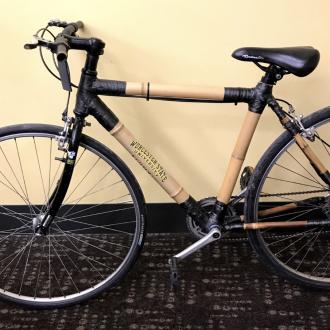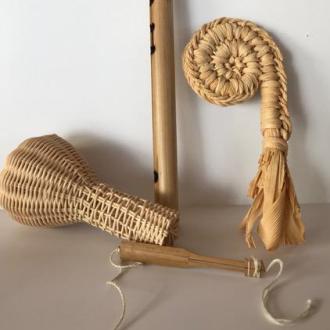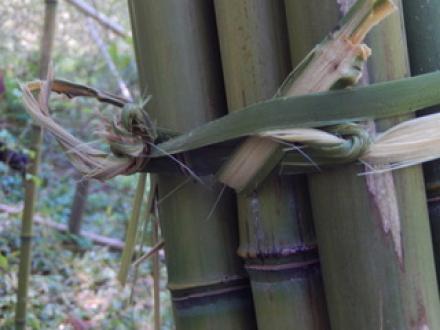
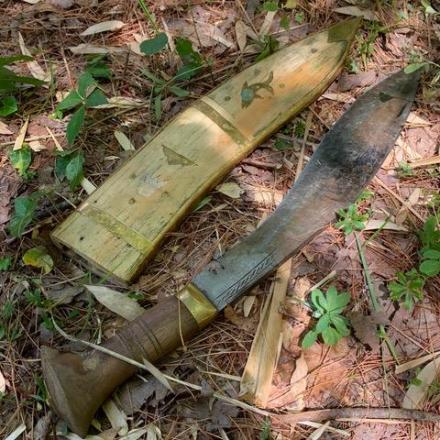

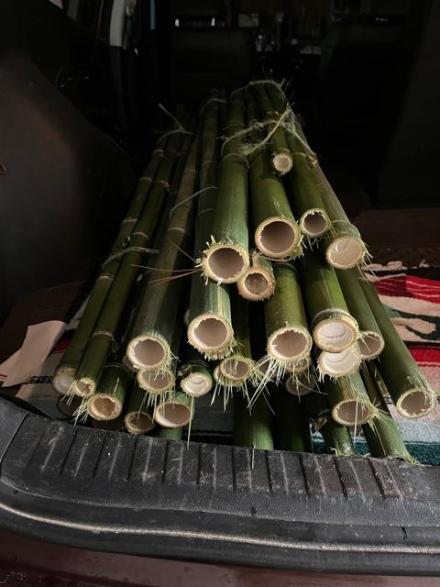
Bamboo is a type of giant grass and one of the prominent materials RAW artisans use for their crafts. Its wood-like shoots vary in color from bright green to yellow or brown and are segmented and hollow inside. They taper towards the top and branches of leaves shoot off in all directions. There are a variety of types of bamboo, ranging in thickness, height, color, lushness, and many other factors. Throughout Asia, it is known for its versatility, strength, and flexibility while still being a relatively lightweight material. These qualities, along with its quick growth rate, make bamboo a strong and sustainable resource, and its use as an eco-conscious alternative in construction and manufacturing is being explored (Van der Lugt 2017).
Stands of bamboo also have rather mystical qualities for many Southeast Asian peoples; tall bamboo hitting against each other in the wind make mournful sounds and sometimes these aural concerts in the forest are associated with spirits and their communications with humans. Southeast Asian peoples often have many names for different types of bamboo and this vocabulary is drawn upon in indigenous poetry and ritual oratory speeches.
The bamboo plant begins as a short stump that resembles asparagus. It is in this early stage that the plant is edible. Within weeks, it grows to be a few feet tall. As it grows, it is nourished from “the leaves it sheds annually, so chemical fertilizers are not necessary” (WBO 2022b). While the bamboo grows in height rather rapidly, it takes three to four years to develop its woody quality. This is the point at which it is harvested, and the craft-making process begins.
Bamboo as Craft Material
Abundant information on bamboo crafts and the RAW artisans who make them is available in the Rodgers and Umunna Refugee Artisans of Worcester: Path to Empowerment booklet, which we rely on here. Please see also The Crafts section in this digital archive.
Within RAW, bamboo is used in a wide array of many different crafts, mostly by Bhutanese artisans. Bamboo is almost endlessly pliable in craftwork. Its ability to be cut up into strips allows it to be woven into pira mats for cushioning or decoration in Bhutanese traditions and in the refugee diaspora. Bamboo is also used in making beautifully intricate winnowing baskets and trays. Bamboo’s physical strength keeps the crafts durable and functional. The versatility of bamboo is one aspect that makes it desirable: its flexibility does not take away from its strength, yet its strength does not stop it from being a comfortable sitting mat.
Basket weaving is another key arena for makers who use bamboo. Not all bamboo baskets are the same, by any means --- there are many different names for different baskets based on their function and shape. They also vary in the tightness in which they are woven. Som Nath, an artisan from Bhutan, recalls the days where he wove jugs “so tightly plaited” that they held milk without there being any seepage or leaks. This impressive feat highlights bamboo’s use as a quality art and practical material, rather than something to be dismissed or underestimated.
Bhim Subba, originally from Bhutan and RAW’s most active basket maker, in Worcester is known for his beautiful baskets and trays. Like many artisans, he begins to process bamboo as soon as possible after harvesting to avoid splintering. Fresh bamboo works best. Bamboo cannot be woven straight away. First, it must be processed to give it the qualities it needs in order to be woven into baskets and trays. Bamboo must be strong yet flexible enough so that it can be bent and interlaced. To achieve this, artisan Bhim Subba soaks the bamboo in water for two to three hours, in the bathtub. This is similar to a technique used to bend wood.
However, since bamboo is much less stiff it need not be steamed. A bathtub in the triple decker is the perfect container for this. Then, he dries the bamboo in his sunny studio. After it has been dried, the bamboo is ready to be cut into strips. This step is crucial- good quality bamboo crafts come from careful cutting of the strips. Bhim makes a point to cut each strip equal in width, and his ability to do so is exceptional. After this, he continues to perfect the strips by removing the splintering pieces that would otherwise make the finished crafts hard to hold.
In the same sunny studio, Bhim lays the bamboo strips out in a pattern on the floor. Carefully counting them, Bhim begins weaving the pattern out flat to make the base of the basket. As he is weaving, he takes advantage of the natural color variation between the front and back of these strips to make designs. Bamboo has beautiful natural colors and a sheen that makes it aesthetically pleasing, which is another reason why bamboo crafts are so admired. Bhutanese baskets are woven freeform, meaning that there is no mold or frame that they use to form the sides of the baskets. The curvature of the walls of the baskets are made completely from the hand work, adding to the reasons why many enjoy Bhutanese bamboo baskets.
Other crafts made from bamboo in collaboration with RAW include birdcages, fish traps, and mouth harps. These unique crafts provide Bhutanese artisans with a welcome challenge, and bamboo’s woody quality and strength again makes for the perfect material. Bamboo flutes are made especially by carpenter Dhan Bhuljal, also from Bhutan. As described in the 2017 Path to Empowerment booklet, after sanding the bamboo, he soaks it in water “in order to make a good tune” (Rodgers and Umunna 2017, 23). He then buffs the bamboo until it is smooth and carves tiny holes into it. Dhan’s flutes and mouth harps are examples of just how playful bamboo can be.
It is clearly a craft that excites Dhan, especially with the thought of creating a bamboo bike frame! That has indeed been a project for some of the RAW artisans, who worked in collaboration that time with a local bicycle shop. Their partners there included the nonprofit Bamboo Bicycles of Beijing and Worcester State University. The founder of the nonprofit trained RAW artisans in the construction of the bamboo bicycle, which was later displayed at the “Crafting a New Home’ exhibition at the Worcester Center for Crafts, in January-February, 2020.
Many of the refugee artisans use bamboo for items other than their crafts, for instance as stakes for their garden vegetables or in constructing altars for celebrations. Some Burmese weavers, such as Tu Meh, use bamboo to support their looms and make warping boards. Bamboo threads are also used to make some textiles; as noted in our Threads section this yields a particularly elegant, supple, lightweight fiber with a good hand. Some of the Nepali-speaking Bhutanese textile weavers, such as Maita Subba, are branching out into basketmaking. The ability of the artisans to look at the same material and find so many different ways to make crafts from it is illustrative of their skill, knowledge, and resourcefulness.
Where do the artisans get their bamboo?
One may be surprised to learn that bamboo grows far beyond the tropical climates typically associated with their flourishing -- bamboo can even sprout up in Massachusetts! In fact, bamboo can grow almost anywhere, and is indigenous to “all [continents] except Europe and Antarctica.” (WBO 2022b) People around the world grow bamboo in their backyards as well as commercially. Thanks to RAW’s relationship with Suzanne Lucas, the CEO of the World Bamboo Organization (WBO), the RAW artisans collect their materials in Plymouth, MA. They also harvest some thinner types of bamboo from family backyards in Worcester but this yields somewhat lower quality material.
Suzanne collaborates with RAW and its artisans to provide bamboo. She supplies bamboo to the artisans as a donation to support their craft work. In turn, the artisans thank her with gifts of handmade textiles and baskets woven from the same bamboo they harvested. With Joan and Ellen of RAW, about ten of the artisans make periodic visits to Suzanne’s large bamboo grove in Plymouth. Susanne’s friendship with the artisans is apparent in her generosity and respect for their craft making knowledge; she takes pleasure in the joy the artisans find in visiting her.
So, about twice a year, the RAW troupe travels together to Plymouth with lists and ideas of what they are looking for. They are very intentional. The artisans know best what diameter and type of bamboo fits their particular crafts and they actively seek out those varieties in the stands of bamboo at the farm. They search for bamboo that fits their project’s needs, rather than coming up with a project matched to the bamboo itself. Using machetes and saws, the artisans cut the bamboo at its base. Then, they may remove the leaves or chop the bamboo into smaller segments, depending on what they require for their crafts. They use rope, or strips of bamboo joined together, to tie their bundles. At the end of the trip, RAW artisans have truck-fulls of bamboo to bring back home and begin crafting.
How does Massachusetts bamboo compare?
It may go without saying that bamboo growing in colder climates with snowy winters would be considerably different from the plant as found in warmer, tropical environments. The home countries of the artisans, such as Bhutan and Burma, have hotter and more humid climates than Massachusetts; they have rainy seasons but no winters per se, with temperatures that regularly fall below freezing. Bamboo in the tropics grows to much wider diameters and in greater variety and is a very common plant and building material. Due to Massachusetts’ hot summers and cold winters, only certain species of bamboo thrive here. Larger bamboo shoots cannot grow in this climate, so much of the bamboo here tends to grow a maximum of two to three inches in diameter.
Surprisingly enough, most of the bamboo at Susanne Lucas’s farm makes it through our harsh winters, but easily grows back if any is lost during the season. Suzanne Lucas also keeps specialty bamboo in her two greenhouses to protect them from the weather.
When the artisans heard about the opportunity to harvest it nearby, they pictured bamboo that was very similar to those they know well. Upon arrival in Plymouth, or the backyard bamboo gardens of some Worcester residents, you could imagine how there could be some disappointment and laughter when they saw how different Massachusetts bamboo was. This bamboo was harder and not as pliable as that of their home countries. It is important to note that bamboo grown here is not of less quality than those in their home countries- it is just different, and that takes some adjusting to. Still, appreciative of the opportunity to harvest quality bamboo so close to home, the artisans learned to work this Worcester bamboo to achieve the same results and/or adapt their crafts. Art is often a challenging puzzle, where artisans are constantly workshopping new ideas, techniques, and designs through trial and error. This is no different. Through problem solving, the artisans learned to create remarkable crafts from unfamiliar Massachusetts forms of the plant.
Traditions of Bamboo Use: A Changing Landscape
In Asia, bamboo is grown both wildly and cultivated in farms. It is a common material for everyday life and is a prevalent building material. It is appreciated as a great alternative to wood and metal, which tend to be much more expensive. Bamboo is a very effective material in scaffolding as well. In refugee camps, many times refugees have to build their own houses out of bamboo alongside other materials such as palm fronds for roofs (Fusunyan et al, 2016). In some homes, bamboo is used to make plated screens in the walls. While it is a strong material, refugee families in the camps had to dismantle and rebuild every few years to ensure the safety and durability of their homes (Fusunyan et al, 2016).
Alongside other materials such as mud and mortar, bamboo structures are earthquake resistant. This is due to their strength as well as flexibility. Its lightweight quality makes it safer in earthquakes as well (Van der Lugt 2017). Bamboo is also a common ingredient in Asian cuisines. Many people stuff bamboo linings with rice and condiments and steam it for a delicious meal or ceremonial food.
Bamboo makes for durable everyday objects, such as those the artisans make in Worcester today, but is especially plentiful in the artisans’ home countries and refugee camps. It is typical to find bamboo beds, chairs, and tables in homes. Winnowing trays, milk jugs, and plow parts are commonly made from this giant grass. Some of the RAW artisans learned to work with bamboo from masters growing up, observing as they carefully wove baskets. Others did not learn to work with bamboo before arriving in refugee camps. Here in Worcester, their bamboo crafts are admired for their quality weaving, beauty, and practicality and many refugee or former-refugee families have now switched over to factory-made furniture that they have purchased from stores or gotten from neighbors or from nonprofits.
From its prevalence inside the home and out, it is clear that bamboo is an important part of the artisans’ cultures. Bamboo is used to make altars for weddings, house blessings, funerals, and celebrations. These celebrations, including one described to us as a Nepali Puja festival, require the best bamboo, so it must be freshly harvested. These celebrations honor the natural world and ancestors. Here in Massachusetts, traditions continue, and many artisans use bamboo from Susanne’s farm in Plymouth to prepare for them. Sometimes a trip to Plymouth is not possible, however, so the artisans resort to an emergency source of bamboo: the backyard garden of two Holy Cross Asian Studies professors. While this bamboo is much thinner, having any sort of bamboo for these important traditions is appreciated.
There is no denying the meaningfulness of bamboo to RAW artisans, in both craft and culture. They pull from tradition while also adapting their crafts to Massachusetts, further proving the versatility and strength of both the bamboo and the artisans themselves. It is no surprise that their bamboo crafts are admired by many here in central Massachusetts and around the world.
Items
Some of the Nepali-speaking Bhutanese refugees practice a religion similar to Buddhism and Hinduism. For more information on the Hindu practice of performing Puja:
Warden, A.C. 1996. “Puja: Expressions of Hindu Devotion.” Arthur M. Sackler Gallery. Smithsonian National Museum of Asian Art website. Accessed July 28, 2022
Visit the World Bamboo Organization for more information on their mission, projects, or bamboo ambassadors.
Fusunyan, Mark, Courtney Temple, and Alyse Wheelock, illustrations by Hay Reh. 2016. When We Were Home: A Collection of Memories from Burmese Refugee Youth. Worcester MA: WRAP, privately published.
Rodgers, Susan, and Martina C. Umunna 2017. “Path to Empowerment: Refugee Artisans of Worcester.” Holy Cross Center for Liberal Arts in the World, JD Power Center. Worcester, MA.
Van der Lugt, Pablo. 2017. “Bamboo to save the world.” TEDxErasmusUniversityRotterdam. TED, accessed July 8, 2022.
World Bamboo Organization (WBO). 2022a. “Our Mission.” World Bamboo Organization website, accessed July 8, 2022.
World Bamboo Organization (WBO). 2022b. “Our commitment: to provide the realities, the truth, and the potentials of bamboo.” World Bamboo Organization website., accessed July 8, 2022.

